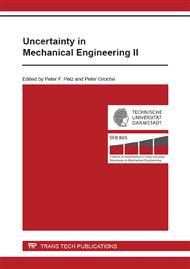p.34
p.45
p.57
p.67
p.78
p.89
p.99
p.109
p.121
Opportunities and Limitations of Structural Intensity Calculation Regarding Uncertainties in the NVH Design of Complex Vehicle Body Structures
Abstract:
The calculation of the structural intensity allows for a better understanding of the NVH behavior of complex structures as it shows vibratory energy flows between an excitation and radiating areas. However, the information gathered is underlying aleatory and epistemic uncertainties and needs to be dealt with carefully. In this paper two aspects are discussed: Firstly how the structural intensity calculation helps to reduce uncertainty in NVH design and secondly what currently existing uncertainties need to be considered and how they can be further reduced. This does not only include an improvement of the current calculation process itself but also an extension towards an integrated, holistic calculation of vibratory energetic quantities for structure-borne and air-borne sound.
Info:
Periodical:
Pages:
78-86
Citation:
Online since:
November 2015
Authors:
Keywords:
Price:
Сopyright:
© 2015 Trans Tech Publications Ltd. All Rights Reserved
Share:
Citation:


